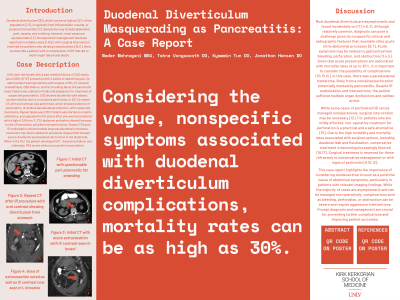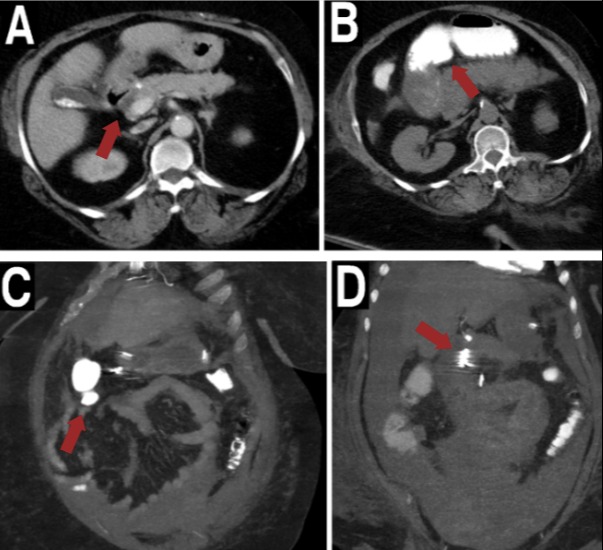Sunday Poster Session
Category: Small Intestine
P1320 - Duodenal Diverticulum Masquerading as Pancreatitis: A Case Report
Sunday, October 22, 2023
3:30 PM - 7:00 PM PT
Location: Exhibit Hall

Has Audio

Nader Mehregani
Kirk Kerkorian School of Medicine
Las Vegas, NV
Presenting Author(s)
Nader Mehregani, , Tahne Vongsavath, DO
Kirk Kerkorian School of Medicine, Las Vegas, NV
Introduction: Duodenal diverticulum (DD), which may be present in up to 22% of the population, is typically from inflammation, trauma, or surgical intervention. Symptoms may include abdominal pain, nausea, and vomiting, however, most cases are asymptomatic. Nonoperative management has been reported in multiple cases, with surgical intervention reserved for patients who develop complications. Here, we describe a patient with a complication of DD that led to multi-organ failure and death.
Case Description/Methods: A 60-year-old female with a past medical history of CAD status post CABG, HFrEF presented with 2 weeks of abdominal pain. On admission, the patient was hypotensive with a lipase of 164. CT showed cholelithiasis, CBD dilation, and fat stranding about the pancreatic head. Patient was started on fluids and analgesics for treatment of suspected pancreatitis. EGD showed duodenitis with edema, unclear whether due to a contained perforation or DD. So repeat CT with oral contrast was performed, which showed evidence of pancreatitis, ill-defined para-duodenal collection, with suspected hematoma. Repeat lipase was 1233. Patient was started on empiric antibiotics and upgraded to ICU status after she was found altered with a hemoglobin of 5.6 from 11. CTA abdomen and pelvis showed increase in size of hematoma, possible hemoperitoneum. Repeat CTA post IR embolization showed stable large para-duodenal hematoma, consistent free fluid in abdomen and pelvis. Repeat EGD showed severe duodenitis and duodenal obstruction in the distal bulb. While in the ICU, the patient developed SVT, respiratory failure, and ultimately, PEA arrest without successful resuscitation.
Discussion: Most duodenal diverticula are asymptomatic and found incidentally on CT. Although relatively common, diagnosis can pose a challenge given its nonspecific clinical and radiographic features. Acute symptoms may be related to gastrointestinal bleeding, perforation, and obstruction. Given that acute presentations are associated with mortality rates of up to 31%, it is important to consider the possibility of complications. In this case, there was a paraduodenal hematoma, likely from a contained perforation potentially masked by pancreatitis. Despite IR embolization and interventions, the patient did not recover and refused surgery on multiple occasions. Non-operative management for perforations may be practical and safe in mild cases, with surgical treatment reserved for refractory patients or signs of peritonitis.

Disclosures:
Nader Mehregani, , Tahne Vongsavath, DO. P1320 - Duodenal Diverticulum Masquerading as Pancreatitis: A Case Report, ACG 2023 Annual Scientific Meeting Abstracts. Vancouver, BC, Canada: American College of Gastroenterology.
Kirk Kerkorian School of Medicine, Las Vegas, NV
Introduction: Duodenal diverticulum (DD), which may be present in up to 22% of the population, is typically from inflammation, trauma, or surgical intervention. Symptoms may include abdominal pain, nausea, and vomiting, however, most cases are asymptomatic. Nonoperative management has been reported in multiple cases, with surgical intervention reserved for patients who develop complications. Here, we describe a patient with a complication of DD that led to multi-organ failure and death.
Case Description/Methods: A 60-year-old female with a past medical history of CAD status post CABG, HFrEF presented with 2 weeks of abdominal pain. On admission, the patient was hypotensive with a lipase of 164. CT showed cholelithiasis, CBD dilation, and fat stranding about the pancreatic head. Patient was started on fluids and analgesics for treatment of suspected pancreatitis. EGD showed duodenitis with edema, unclear whether due to a contained perforation or DD. So repeat CT with oral contrast was performed, which showed evidence of pancreatitis, ill-defined para-duodenal collection, with suspected hematoma. Repeat lipase was 1233. Patient was started on empiric antibiotics and upgraded to ICU status after she was found altered with a hemoglobin of 5.6 from 11. CTA abdomen and pelvis showed increase in size of hematoma, possible hemoperitoneum. Repeat CTA post IR embolization showed stable large para-duodenal hematoma, consistent free fluid in abdomen and pelvis. Repeat EGD showed severe duodenitis and duodenal obstruction in the distal bulb. While in the ICU, the patient developed SVT, respiratory failure, and ultimately, PEA arrest without successful resuscitation.
Discussion: Most duodenal diverticula are asymptomatic and found incidentally on CT. Although relatively common, diagnosis can pose a challenge given its nonspecific clinical and radiographic features. Acute symptoms may be related to gastrointestinal bleeding, perforation, and obstruction. Given that acute presentations are associated with mortality rates of up to 31%, it is important to consider the possibility of complications. In this case, there was a paraduodenal hematoma, likely from a contained perforation potentially masked by pancreatitis. Despite IR embolization and interventions, the patient did not recover and refused surgery on multiple occasions. Non-operative management for perforations may be practical and safe in mild cases, with surgical treatment reserved for refractory patients or signs of peritonitis.

Figure: Figure A: Initial CT with questionable peri-pancreatic fat stranding
Figure B: Repeat CT after IR procedure with oral contrast showing diverticulum from stomach
Figure C: Initial CT with acute extravasation with IV contrast seen in bowel
Figure D: Area of extravasation noted as well as IV contrast now seen in L intestine
Figure B: Repeat CT after IR procedure with oral contrast showing diverticulum from stomach
Figure C: Initial CT with acute extravasation with IV contrast seen in bowel
Figure D: Area of extravasation noted as well as IV contrast now seen in L intestine
Disclosures:
Nader Mehregani indicated no relevant financial relationships.
Tahne Vongsavath indicated no relevant financial relationships.
Nader Mehregani, , Tahne Vongsavath, DO. P1320 - Duodenal Diverticulum Masquerading as Pancreatitis: A Case Report, ACG 2023 Annual Scientific Meeting Abstracts. Vancouver, BC, Canada: American College of Gastroenterology.
